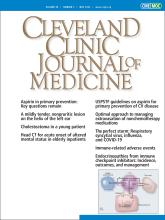Article Figures & Data
Tables
Trial Population Findings ASCEND4 15,480 patients with diabetes and no prior CVD history Therapy resulted in a 12% reduction in myocardial infarction and ischemic stroke
Therapy resulted in a 30% increased risk for a major bleeding event, especially prominent in patients age 60 or olderARRIVE5 12,546 patients with mean 17% 10-year CVD risk No significant benefit in CVD prevention with therapy compared with placebo
Twofold increase in gastrointestinal bleeding seen in aspirin therapy groupASPREE6,7 19,114 patients, average age 74 Therapy provided no benefit in preventing first nonfatal cardiovascular event or death
Therapy showed a 30% increased risk of major nonfatal hemorrhage, particularly in upper-gastrointestinal bleeds and intracranial hemorrhageARRIVE = Aspirin to Reduce Risk of Initial Vascular Events; ASCEND = A Study of Cardiovascular Events in Diabetes; ASPREE = Aspirin in Reducing Events in the Elderly; CVD = cardiovascular disease
- TABLE 2
A comparison of the 2022 USPSTF and 2019 ACC/AHA guidelines for daily aspirin use for primary prevention, by age
Age 40 to 60 Age 60 to 70 Age > 70 USPSTF 20221 Individualize for risk > 10% for CVD events using pooled cohort equation (grade C) No aspirin (grade D) No aspirin (grade D) ACC/AHA 201910 Individualize for higher risk patients (COR IIb/LOE A) Individualize for higher risk patients (COR IIb/LOE A) No aspirin (COR III/LOE B-R) ACC = American College of Cardiology; AHA = American Heart Association; COR = class of recommendation; COR IIb/LOE A = high-quality evidence showing treatment may be reasonable, but effectiveness is not well established; COR III/LOE B-R = moderate-quality evidence showed no benefit and potential harm; CVD = cardiovascular disease; grade C = small benefit in select patients; grade D = no net benefit or harm outweighs benefit; LOE = level of evidence






